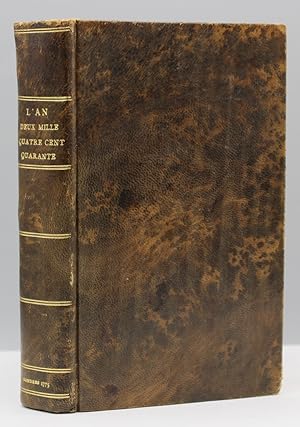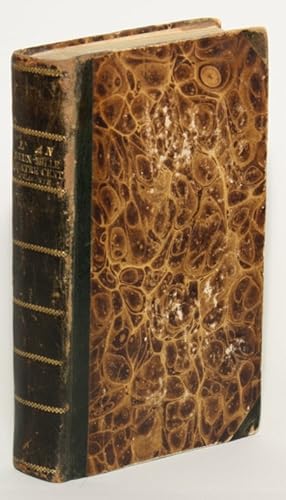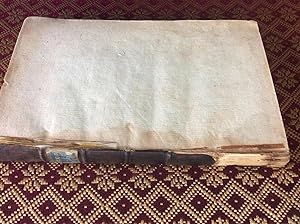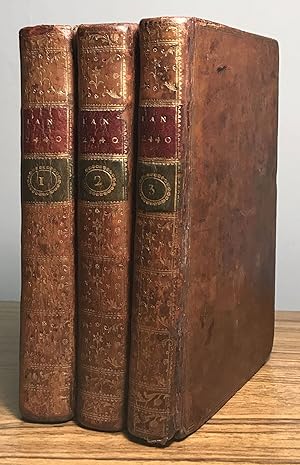L'an Deux Mille Quatre Cent Quarante, First Edition (6 results)
Product Type
- All Product Types
- Books (6)
- Magazines & Periodicals
- Comics
- Sheet Music
- Art, Prints & Posters
- Photographs
- Maps
-
Manuscripts &
Paper Collectibles
Condition
- All Conditions
- New
- Used
Binding
Collectible Attributes
- First Edition
- Signed
- Dust Jacket
- Seller-Supplied Images (5)
- Not Printed On Demand
Seller Location
Seller Rating
-
L'An Deux Mille Quatre Cent Quarante. Rêve s'il en fut jamais.
Seller: Librairie Victor Sevilla, Paris, France
First Edition
A Londres 1774. In- 12 relié de 479 pages au format 10 x 3,5 x 17 cm. Demi maroquin avec plats en papier marbré. Dos rond avec étiquette d'appartenance de Vittorio Ferrari. Titre et fleurons dorés et gravés. Nom de l'auteur et annotation à la plume en page de titre. Plats et coins avec infimes frottis. Intérieur très frais. Rarissime tirage en date de 1774 mais qui reproduit apparemment l'édition originale. En effet, il n'est pas fait mention en page de titre de cette note : .Nouvelle Edition, revue et corrigée par l'Auteur, qui a jugé à propos de refondre le Chapitre de la Bibliothèque du Roi et de plus il manque en fin d'ouvrage le chapitre intitulé : Supplément au chapitre de la bibliothèque du Roi tel qu il étoit dans les précédentes éditions. Très bel état général pour cette Utopie, considérée comme l'un des tous premiers textes d'Anticipation. De toute rareté. Exemplaire enrichi d'une note manuscrite, explicative, rédigée en italien, sur feuille volante.
-
L'An deux mille quatre cent quarante. R ve s'il en fut jamais
Published by A Londres: 1775., 1775
Seller: Michael R. Thompson Books, A.B.A.A., Los Angeles, CA, U.S.A.
First Edition
Mercier (1740-1814) was a prolific writer of plays, novels, and pamphlets. Firmly in the tradition of the Enlightenment, he was influenced by Rousseau, Diderot, Holbach, Mably, and others. Robert Darnton writes: "There is no better writer to consult," Robert Darnton writes, "if one wants to get some idea of how Paris looked, sounded, smelled, and felt on the eve of the Revolution" (The Forbidden Best-Sellers of Pre-Revolutionary France, p. 118). despite its self-proclaimed character of fantasy.L'An 2440 demanded to be read as a serious guidebook to the future. It offered an astonishing new perspective: the future as a fait accompli and the present as a distant past. Who could resist the temptation to participate in such a thought experiment? And once engaged in it, who could fail to see that it exposed the rottenness of the society before his eyes, the Paris of the eighteenth century?" (ibid, p. 120). Gershon Legman (1917-1999) pioneered the serious academic study of erotic and taboo materials in folklore. He is particularly known for his work, Rationale of the Dirty Joke: An Analysis of Sexual Humor (1968) and for his several books on limericks. Small octavo [viii], 472, [4] pp. Later mottled sheep. Gilt, flat spine, edges stained red. Light dampstain in margin of half-title, a little light foxing. A very good copy. Gershon Legman's copy, with his signature and the date 1984 in ink on the front free endpaper. Early edition of this influential utopian novel, noteworthy for being set in the future. "L'an deux mille quatre cent quarante was first published in 1771. It was swiftly banned in France and was put on the Inquisition's list of forbidden books in 1773, but it became a runaway best seller, going through at least twenty-five editions. Cioranescu 44468, listing the first edition. Darnton, The Corpus of Clandestine Literature in France 1769-1789, p. 17, no. 30.
-
L'AN DEUX MILLE QUATRE CENT QUARANTE. RÊVE S'IL FÛT JAMAIS. Nouvelle Edition, Revue & Corrigée par l'Auteur, qui a Jugé à Propos de Refondre le Chapitre de la Bibliothèque du Roi .
Published by 1774., A Londres [i.e. Paris], 1774
Seller: Currey, L.W. Inc. ABAA/ILAB, Elizabethtown, NY, U.S.A.
First Edition
Octavo, pp. [iii-iv] v-xii 1-410, early three-quarter black leather and marbled boards, all edges stained yellow. First printing of the second edition, revised and corrected. "This first utopia set in future time was one of the eighteenth century's most successful books. It was immediately banned in France, put on the Inquisition's list of forbidden books in 1773, and condemned in Madrid in 1778 as a blasphemous work whose distributors, if discovered, would be fined five hundred ducats and sentenced to six years in prison. THE YEAR 2440 had eleven editions in French between 1771 and 1799, as well as two English translations and translations into Dutch, Italian, and German. Investigation of its printing history leads Everett Wilkie to conclude that 'there were 18,000 copies in print in three languages by the end of 1772 and 30,000 copies by the end of 1782, at which point it had spread thoroughly over Europe. 63,000 copies had been printed by Mercier's death' in 1814. The book was less successful across the Atlantic, but a 1795 Philadelphia edition was 'nevertheless, the first utopian novel published in North America.' George Washington and Thomas Jefferson owned copies of THE YEAR 2440." - Alkon, Origins of Futuristic Fiction, p. 117. "The theories of progress that pervaded European thought in the eighteenth century were born in France, a politically unsubmissive country which was preparing its revolution . Inspired by the feeling of trust that characterized the Enlightenment, in 1771 the French writer Louis-Sébastien Mercier published the first uchronia, L'AN 2440 . By favoring the notion of time and offering a vision of a future of happiness, uchronia acquired a historical dimension. History was now envisaged as a process of infinite improvement, and utopia, in the spirit of uchronia, was presented as a synchronic representation of one of the rings in the chain of progress . In this way, utopias became dynamic, and promoted the idea that man had a role to fulfill." - Fátima Vieira, Clays, ed., Utopian Literature, p. 10. Mercier proposed a break with the past to create a better future. His "utopia provided a detailed and harsh critique of the ancien régime. Consequently, it was immediately banned upon its initial publication but went on to become a bestseller. It follows the classical utopian paradigm in proposing order based on reason, moderation and work. For Mercier, the path towards a better society lay in the triumph of reason over passion and the sacrifice of individual desires for the common good." - Nicole Pohl, Clays, ed., Utopian Literature, p. 74. ". although the earliest specimens of futuristic fiction were in English, the glory of discovering the true potentialities of the genre belongs to the French -- to Mercier who established the first satisfactory model of the new fiction . The utopian prophecy of L'AN 2440, the first influential story of the future in world literature, became one of the most widely read books in the last quarter of the eighteenth century. The translations into Dutch and German, the English and American editions, and the many imitations show how Mercier beguiled his readers in two continents with the vision of a dream come true." - Clarke, The Pattern of Expectation 1644-2001, p. 23. Mercier's bibliographer, Everett C. Wilkie, Jr., states that only a few editions of this work are of textual importance: the first edition of 1771, this edition of 1774, the 1786 edition in 3 volumes, and the one of An VII (1798). This 1774 text has not been translated into English. See Alkon, Origins of Futuristic Fiction, esp. pp. 117-29. Anatomy of Wonder (1976) 1-29; (1981) 1-123; (1987) 1-63; (1995) 1-63; and (2004) II-757. Bleiler, Science-Fiction: The Early Years 1476. Claeys (ed), Utopian Literature, pp. 10; 74; 138, Clarke, Tale of the Future (1978), p. 2. Fortunati and Trousson (eds), Dictionary of Literary Utopias, pp. 43-5. Howgego, Encyclopedia of Exploration: Invented and Apocryphal Narratives of Travel M35. Lewis, Utopian Literature, pp. 120-22. Negley, Utopian Literature: A Bibliography 772 (not recording this edition). Versins, Encyclopédie de l'Utopie, des Voyages Extraordinaires et de la Science Fiction, p. 582. Bleiler (1978), p. 138. Reginald 10017. Binding rubbed at edges, corner tips a bit worn, old repair to upper right corner of title leaf, some damp staining to the text block, mostly to upper margins of several signatures, most noticeably signatures C and Y, a very good copy with a fairly clean interior. A scarce edition of this seminal book. (#90772).
-
Memoirs of the Year Two Thousand Five Hundred, Volume 1 (translation of: L'an deux mille quatre cent quarante. reve s'il en fut jamais)
Published by W. Wilson, Dublin, 1772
Seller: Boojum and Snark Books, Kanab, UT, U.S.A.
Book First Edition
No Binding. Condition: Good. No Jacket. 1st Edition. An exceedingly rare imprint of this utopian novel, first published in French in 1771. This edition was published in Dublin in 1772, and cannot be found in OCLC (the first edition in English is listed in OCLC as a London imprint in 1772: 2 vol. G. Robinson). This is a utopian novel set in the year 2440. Book block only, lacking boards, but majority of leather spine strip still present, with raised bands; binding of book block still sound. 6 3/8 x 4 inches, 184 pp. Mild dampstaing near spine. Otherwise, pages clean. This is volume 1 only (but volume 2 is available to read online (h t t p s : / / a r c h i v e . o r g /details/memoirsofyeartwo02merc --- without the spaces). Rare indeed. "Mercier's L'An 2440, rêve s'il en fut jamais (literally, "The Year 2440: A Dream If Ever There Was One"; translated into English as Memoirs of the Year Two Thousand Five Hundred [sic]; and into German as Das Jahr zwey tausend vier hundert und vierzig: Ein Traum aller Träume) is a utopian novel set in the year 2440. An extremely popular work (it went through twenty-five editions after its first appearance in 1770), the work describes the adventures of an unnamed man, who, after engaging in a heated discussion with a philosopher friend about the injustices of Paris, falls asleep and finds himself in a Paris of the future. Darnton writes that "despite its self-proclaimed character of fantasy.L'An 2440 demanded to be read as a serious guidebook to the future. It offered an astonishing new perspective: the future as a fait accompli and the present as a distant past. Who could resist the temptation to participate in such a thought experiment? And once engaged in it, who could fail to see that it exposed the rottenness of the society before his eyes, the Paris of the eighteenth century?" Mercier's hero notes everything that catches his fancy in this futuristic Paris. Public space and the justice system have been reorganized. Its citizens' garb is comfortable and practical. Hospitals are effective and based on science. There are no monks, priests, prostitutes, beggars, dancing masters (i.e. teachers), pastry chefs, standing armies, slavery, arbitrary arrest, taxes, guilds, foreign trade, coffee, tea or tobacco and all useless and immoral previously-written literature has been destroyed. Mercier's future is not wholly utopian. The extremes of wealth and poverty have been abolished; nevertheless, the poor still exist. There is little economic development and the population of France has increased only by 50%." (1722RO089).
-
L'AN DEUX MILLE QUATRE CENT QUARANTE. RÊVE S'IL FÛT JAMAIS; SUIVI DE L'HOMME DE FER, SONGE . Nouvelle Edition .
Published by 1786., N.p. [Paris], 1786
Seller: Currey, L.W. Inc. ABAA/ILAB, Elizabethtown, NY, U.S.A.
First Edition
12mo, three volumes: pp. [i-v] vi-vii [viii] ix-xvi 1-380 [381-382] [383-384: blank]; [i-iv] 1-381 [382-383] [384: blank]; [i-iv] 1-312 [313-314] [315-316: blank] [note: all three half titles present], engraved frontispiece inserted in each volume, contemporary eighteenth-century full calf, front and rear panels ruled in gold, spine panels richly tooled in gold, brown leather title pieces and green leather number pieces, marbled endpapers. First printing of the third edition, revised and enlarged. The first printing of the third (and best) edition. "This first utopia set in future time was one of the eighteenth century's most successful books. It was immediately banned in France, put on the Inquisition's list of forbidden books in 1773, and condemned in Madrid in 1778 as a blasphemous work whose distributors, if discovered, would be fined five hundred ducats and sentenced to six years in prison. THE YEAR 2440 had eleven editions in French between 1771 and 1799, as well as two English translations and translations into Dutch, Italian, and German. Investigation of its printing history leads Everett Wilkie to conclude that 'there were 18,000 copies in print in three languages by the end of 1772 and 30,000 copies by the end of 1782, at which point it had spread thoroughly over Europe . 63,000 copies had been printed by Mercier's death' in 1814. The book was less successful across the Atlantic, but a 1795 Philadelphia edition was 'nevertheless, the first utopian novel published in North America.' George Washington and Thomas Jefferson owned copies of THE YEAR 2440." - Alkon, Origins of Futuristic Fiction, p. 117. "The theories of progress that pervaded European thought in the eighteenth century were born in France, a politically unsubmissive country which was preparing its revolution . Inspired by the feeling of trust that characterized the Enlightenment, in 1771 the French writer Louis-Sébastien Mercier published the first uchronia, L'AN 2440 . By favoring the notion of time and offering a vision of a future of happiness, uchronia acquired a historical dimension. History was now envisaged as a process of infinite improvement, and utopia, in the spirit of uchronia, was presented as a synchronic representation of one of the rings in the chain of progress . In this way, utopias became dynamic, and promoted the idea that man had a role to fulfill." - Fátima Vieira, Clays, ed., Utopian Literature, p. 10. Mercier proposed a break with the past to create a better future. His "utopia provided a detailed and harsh critique of the ancien régime. Consequently, it was immediately banned upon its initial publication but went on to become a bestseller. It follows the classical utopian paradigm in proposing order based on reason, moderation and work. For Mercier, the path towards a better society lay in the triumph of reason over passion and the sacrifice of individual desires for the common good." - Nicole Pohl, Clays, ed., Utopian Literature, p. 74. ". although the earliest specimens of futuristic fiction were in English, the glory of discovering the true potentialities of the genre belongs to the French -- to Mercier who established the first satisfactory model of the new fiction . The utopian prophecy of L'AN 2440, the first influential story of the future in world literature, became one of the most widely read books in the last quarter of the eighteenth century. The translations into Dutch and German, the English and American editions, and the many imitations show how Mercier beguiled his readers in two continents with the vision of a dream come true." - Clarke, The Pattern of Expectation 1644-2001, p. 23. Mercier's bibliographer, Everett C. Wilkie, Jr., states that only a few editions of this work are of textual importance: the first edition of 1771, the edition of 1774, this greatly expanded 1786 edition in 3 volumes, and the one of An VII (1798). This 1786 text has not been translated into English. See Alkon, Origins of Futuristic Fiction, esp. pp. 117-29. Anatomy of Wonder (1976) 1-29; (1981) 1-123; (1987) 1-63; (1995) 1-63; and (2004) II-757. Bleiler, Science-Fiction: The Early Years 1476. Claeys (ed), Utopian Literature, pp. 10; 74; 138, Clarke, Tale of the Future (1978), p. 2. Fortunati and Trousson (eds), Dictionary of Literary Utopias, pp. 43-5. Howgego, Encyclopedia of Exploration: Invented and Apocryphal Narratives of Travel M35. Lewis, Utopian Literature, pp. 120-22. Negley, Utopian Literature: A Bibliography 772. Versins, Encyclopédie de l'Utopie, des Voyages Extraordinaires et de la Science Fiction, p. 582. Bleiler (1978), p. 138. Reginald 10017. Calf refurbished at spine ends and corner tips with just a bit of loss at upper spine end of volume I and lower spine end of volume III restored, rear free endpaper in volume I and front free endpaper in volume III reattached, two closed tears in preliminary leaves of volume I and tear in lower margin of L7 of volume III professionally mended, tiny chip to lower fore-edge margin of L6 of volume II restored; vertical chip in fore-edge margin of last leaf of volume II (table of contents) just touching one line of text restored, occasional staining to volume III at lower fore-edge margins and to lower fore-edge of frontispiece, occasional tanning to text paper of volume III. Overall, a respectable copy of an uncommon edition of this seminal book. Enclosed in a custom quarter leather clamshell box, velvet lined with leather spine label. (#157093).
-
L'AN DEUX MILLE QUATRE CENT QUARANTE. Rêve s'il en fût jamais ; suivi de L'HOMME DE FER, SONGE. [Ex.] Le présent est gros de l'avenir. Leibnitz. Nouvelle édition avec figures.
Published by 1791, S.l.n.n., 1791
Seller: Librairie L'amour qui bouquine, ALISE SAINTE REINE, France
Book First Edition
Couverture rigide. Condition: Bon. Edition originale. MERCIER (Louis-Sébastien). L'AN DEUX MILLE QUATRE CENT QUARANTE. Rêve s'il en fût jamais ; suivi de L'HOMME DE FER, SONGE. [Ex.] Le présent est gros de l'avenir. Leibnitz. Nouvelle édition avec figures. 1791, S.l.n.n. 3 tomes reliés en 2 volumes, de 220, 212 et 184 pages. 3 frontispices gravés non signés. Relié à la suite : BOESNIER DE L'ORME (Paul). Essai sur les principes de la morale naturelle. Par M. Boesnier de l'Orme. A Blois, chez Jean-François Billault, imprimeur, et se trouve à Paris, chez Onfroy, libraire, 1792 (4)-XII-192 pages. Edition originale très rare. Reliure strictement de l'époque pleine basane fauve marbrée à l'acide, dos lisses avec filets à froid, pièce de titre rose, pièce de tomaison verte. Frottements et usures sur les coupes et aux coins, intérieur frais. Quelques nuances de ton dans le papier de l'An 2440. Rares rousseurs. L An 2440, rêve s il en fut jamais est un roman publié par Louis-Sébastien Mercier en 1771. Il peut être considéré comme le premier roman d'anticipation dans lequel on retrouve le programme de la philosophie des Lumières. Il s'agit de la première utopie qui se situe ailleurs dans le temps, et non plus sur une autre Terre. Il exprime le contraste entre le système de l absolutisme et une société libre, quoique encore sous la gouverne d un roi, où le mérite personnel a remplacé les privilèges héréditaires. Ce texte, dont le plan de rédaction reprend fondamentalement l organisation qui préside à la création du Tableau de Paris de chaque sujet précis en chapitre particulier, est, par-dessus tout, une critique virulente des tares de la société contemporaine. Voulant profondément le bien-être de ses concitoyens, l auteur se sert de ce roman d anticipation comme lieu de dénonciation des abus dans l espoir que les dirigeants en place oseront effectuer les changements nécessaires à la félicité humaine. Mercier critique le fait que le roi ne s occupe pas suffisamment du peuple. Il s occupe du palais, des fêtes, des monuments et de la splendeur, au lieu d améliorer les conditions de vie du peuple et de l éclairer. La morale : « les monuments de l orgueil sont fragiles ». Le narrateur, après une discussion avec un Anglais, qui lui montre toutes les tares de la société française en ce dernier tiers des Lumières (1770, sous le règne de Louis XV), s endort et se réveille, après avoir dormi six cent soixante-dix ans, en 2440 au milieu d une société bien des fois renouvelée dans une France telle que son imagination pourrait la désirer, libérée par une révolution paisible et heureuse. L oppression, les abus ont disparu ; la raison, les lumières, la justice règnent. Tout le roman montre ce Paris renouvelé et se termine sur une scène où le narrateur va à Versailles et retrouve le château en ruine où il rencontre un vieillard qui n'est nul autre que Louis XIV : le vieux roi pleure, miné par la culpabilité. Un serpent, tapi dans les ruines, mord le narrateur qui se réveille. Plusieurs de ses prophéties se réalisèrent du vivant de Mercier qui put dire, par la suite, en parlant de l An 2440, quoiqu il ne crût guère au succès d un mouvement politique avant 1789 : « C est dans ce livre que j ai mis au jour et sans équivoque une prédiction qui embrassait tous les changements possibles depuis la destruction des parlements jusqu'à l adoption des chapeaux ronds. Je suis donc le véritable prophète de la révolution et je le dis sans orgueil. » Ce texte ayant connu trois versions (1771, 1786 et 1799), certains des ajouts de Mercier (principalement des notes en bas de page) montrent un auteur satisfait de préciser que tel abus a cessé depuis la première publication de son uchronie. Notre édition de 1791 reprend le texte de 1786 avec les frontispices qui lui appartiennent également. Cette édition de 1791 est peu commune. L'Essai sur les principes de la morale naturelle de Boesnier de L'Orme qui est relié à la suite de L'An 2440, est un texte rare. Très peu d'exemplaires sont référencés. Ce volume de 193 pages a été i.







![Seller image for L'AN DEUX MILLE QUATRE CENT QUARANTE. Rêve s'il en fût jamais ; suivi de L'HOMME DE FER, SONGE. [Ex.] Le présent est gros de l'avenir. Leibnitz. Nouvelle édition avec figures. for sale by Librairie L'amour qui bouquine](https://pictures.abebooks.com/inventory/md/md31138070455.jpg)